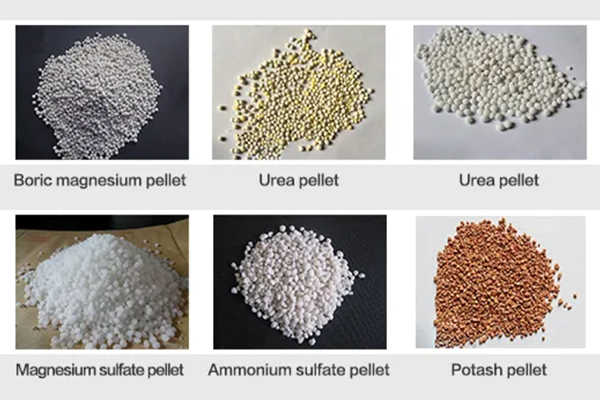Tag: bulk blending fertilizer manufacturing process
How To Start NPK Bulk Blending Fertilizer Production
Bulk blending fertilizer production is a process of combining different granular fertilizers to create a custom blend with specific nutrient ratios. This allows for precise nutrient management tailored to the specific needs of crops or soil conditions. Here are the steps involved in NPK bulk blending fertilizer production:
Raw Material Selection
Choose high-quality granular fertilizers as the base materials for blending. These fertilizers typically include nitrogen (N), phosphorus (P), and potassium (K) sources, such as urea, ammonium nitrate, diammonium phosphate, monoammonium phosphate, potassium chloride, or potassium sulfate.
Select additional granular fertilizers or micro-nutrient sources to meet specific nutrient requirements, such as micronutrients like iron, zinc, or copper.

NPK blending fertilizer making materials
Laboratory Analysis and Formulation
Conduct a soil or plant tissue analysis to determine the nutrient requirements of the target crop or soil. This analysis provides valuable information about the existing nutrient levels and the specific ratios required.
Use the analysis results to formulate the appropriate blend by calculating the amounts of each fertilizer required to achieve the desired NPK ratios. This can be done manually or with the help of software tools.
Weighing and Mixing
The two are essential for quality NPK blending fertilizer prouduciton.
Weigh and feed the granular fertilizers according to the formulated blend ratios. Use precise measurements to ensure accuracy in nutrient content. SX batching machine is an ideal choice here.
Transfer the pre-mixed fertilizers into a blending mixer, either a batch mixer or a continuous blender, depending on the scale of production. Blend the materials thoroughly to achieve a uniform distribution of nutrients throughout the final product.
Set up a NPK bulk blending plant with appropriate equipment, including storage silos, weighing scales, conveyors, mixers. Click here to learn more.
Packaging and Storage
Finally, the end of BB fertilizer making system is packaging the blended fertilizer in appropriate containers, such as bags or bulk containers, based on market demand and customer requirements.
Label the packages with relevant information, including nutrient content, recommended application rates, and handling instructions.
Store the packaged bulk blended fertilizer in a dry and well-ventilated area to maintain its quality and prevent nutrient loss or degradation.
Distribution and Application:
Develop a distribution plan to deliver the bulk blended fertilizer to customers, such as farmers, agricultural retailers, or cooperatives.
Provide guidance and recommendations on proper application rates and methods based on crop needs and soil conditions.
Offer technical support and agronomic advice to customers to ensure effective utilization of the custom-blended fertilizer.
Regular maintenance and calibration of equipment, adherence to quality control protocols, and continuous monitoring of market demands and agronomic trends are crucial for successful NPK bulk blending fertilizer production. If you want to know more about NPK blending fertilizer production, you can visit https://www.fertilizerbusinessplan.com/fertilizer-blending-plant/

NPK Bulk Blending Fertilizer Machines For Sale
March 13, 2024
BB fertilizer production, NPK blending fertilizer machine, NPK fertilizer making cost, NPK fertilizer plant, NPK fertilizer production line
Comments Off on NPK Bulk Blending Fertilizer Machines For Sale
cs
In the quest for improved agricultural efficiency and crop yields, fertilizer plays a pivotal role. Among the various types of fertilizers, NPK (Nitrogen, Phosphorus, and Potassium) bulk blending has emerged as a popular and cost-effective solution. With the advancement of technology comes the invention of the NPK bulk blending fertilizer making machine help us make NPK fertilizer more quickly. This blog will detail the function, benefits, and considerations of using these innovative machines for creating balanced fertilizer blends.
Understanding NPK Bulk Blending
NPK bulk blending is the simplest method to prepare NPK fertilizer, which only makes us of physical mixing of granular fertilizers. Each nutrient component (N-nitrogen, P-phosphorus, and K-potassium) is prepared separately as a granule or prill and then combined in precise proportions to form a homogeneous blend. This blend is tailored to meet the specific nutritional needs of different crops and soil types.
The Role of NPK Bulk Blending Fertilizer Machines
NPK bulk blending fertilizer machines automate the process of mixing different granular fertilizers. The NPK blending system process consists of the following steps:
1. Feeding System: This includes bins or hoppers that contain the separate fertilizer components, which are fed into the blender in accurate proportions.
2. Blending Drum: A large drum where the actual blending of the fertilizer components occurs. The drum rotates to mix the materials thoroughly.
3. Control System: A computerized control panel or system that allows operators to set the quantities and ratios of each nutrient in the mix.
4. Discharge System: Once the blending is complete, the mix is conveyed out of the drum for packaging or bulk storage.
Go here to get more information.
Newest NPK fertilizer mixing system for sale
Benefits of Using NPK Bulk Blending Fertilizer Machines
1. Customization: Farmers can create specific fertilizer blends that match their soil requirements and crop needs, avoiding the one-size-fits-all approach.
2. Efficiency: The blending process is quick and efficient, enabling large quantities of fertilizer to be produced in a short period.
3. Cost-Effectiveness: Bulk blending allows for low cost of NPK fertilizer manufacturing by reducing the labor costs and time associated with manual mixing.
4. Accuracy: Computer-controlled systems ensure precise nutrient ratios, leading to better crop yields and reduced waste of resources.
5. Flexibility: Machines can be adjusted to produce different blends, making them suitable for a variety of crops and changing agricultural demands.
Considerations for Implementing NPK Bulk Blending Fertilizer Machines
1. Investment: The initial cost of purchasing and installing a machine can be significant, but the return on investment can be quickly realized through increased efficiency and crop yields.
2. Training: Operators must be trained to manage the control systems and maintain the machine properly.
3. Maintenance: Regular maintenance is required to keep the machine in good working order and prevent downtime.
4. Quality of Raw Materials: The quality of the granular fertilizers used in the blending process is crucial for creating an effective end product.
5. Storage and Handling: Proper storage and handling solutions must be in place to preserve the quality of both raw materials and the final blended product.
Conclusion
The advent of NPK bulk blending fertilizer machines represents a leap forward in agricultural technology. These machines allow for the efficient, accurate, and cost-effective production of customized fertilizers, leading to enhanced soil management and increased agricultural productivity. As the world moves towards more sustainable and precise farming practices, the role of these machines in fertilizer production is set to become increasingly important.
By investing in an NPK bulk blending fertilizer machine, farmers and fertilizer suppliers can take control of their fertilization strategies, providing crops with the exact nutrients they need to thrive, and ensuring a brighter future for the agricultural industry. If you are inteested in it, you can visit https://www.fertilizerbusinessplan.com/fertilizer-blending-plant/ for more details.
BB fertilizer production machinebulk blending fertilizer manufacturing processNPK fertilizer blending system proceeeNPK fertilizer making costsimplest compound fertilizer production